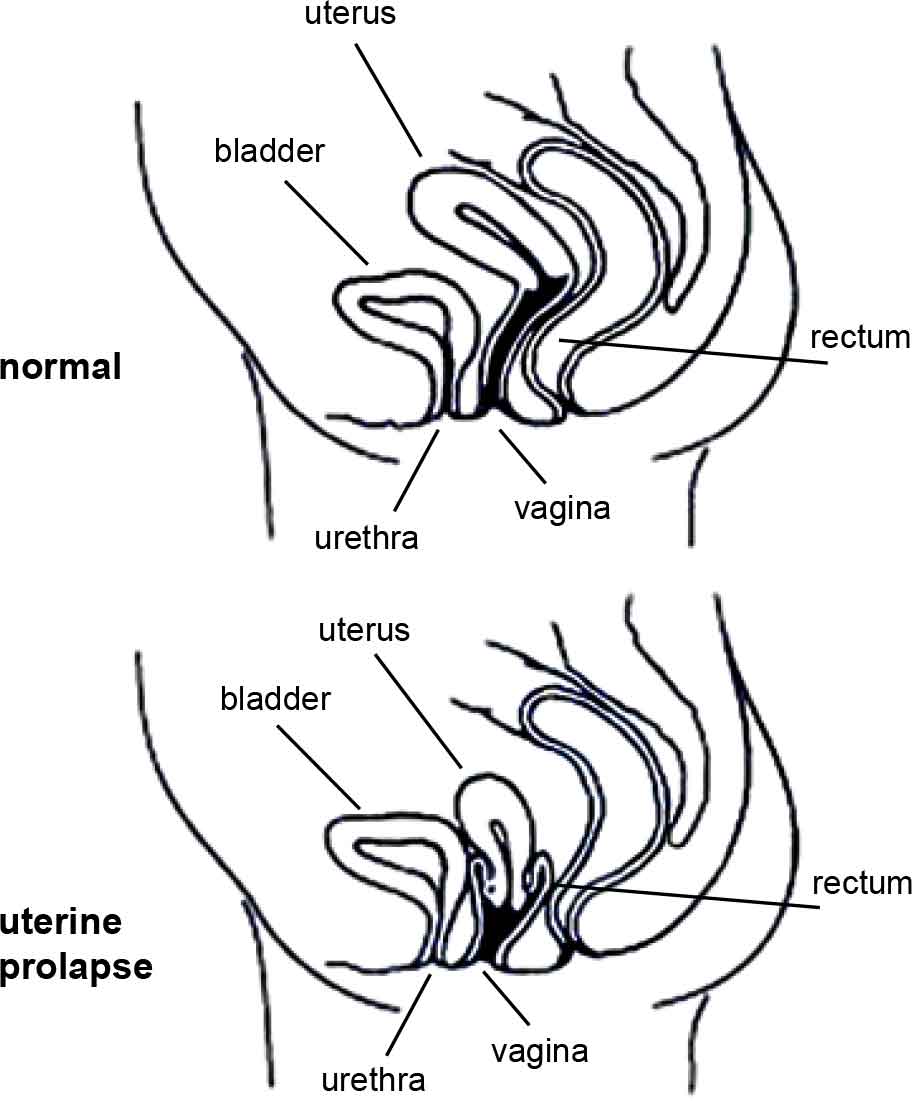What is a vaginal (or pelvic organ) prolapse?Your pelvic organs include your bladder, uterus (womb) and rectum (back passage). These organs are held in place by tissues called “fascia” and “ligaments”. These tissues help to join your pelvic organs to the bony side walls of the pelvis and hold them inside your pelvis. Your pelvic floor muscles also hold up your pelvic organs from below. If the fascia and ligaments are torn or stretched for any reason, and if your pelvic floor muscles are weak, then your pelvic organs (your bladder, uterus, or rectum) might not be held in their right place and they may bulge down into the vagina (birth canal). |
ydmrk.uh>*DRtHRrh>rEkRvJ. (rhwrh>cHwuGD.CHuh>*DR)ecHwuGD.CHuh>*DRvXy.CkmqH.'XvD>< 'XvD>cH)wz.M.vDRIuh>*DRwz.tHRtd.vXtvD>'.0JvXtn.xl.pSDRwH>CmtDRb.w>ud;tDRvX (fascia) 'D; (ligaments)M.vDRIn.xl.wz.tHRrRpXRcHwuGD.CHxl.ys>wz.qlcHtwuGD.CHt*DRyR'l.'D;zD.*X>Cm0JvXtylRwyRM.vDRIecHwuGD.CHxl.ys>wz.ph>uD;qD.xD.ecHwuGD.CHvXtzDvmwuyRph>uD;M.vDRIxl.ys>cHcgvXmvXw>,XRxD.tDR'ftzDcd.tod;rh>nmrhwrh>xk;,JmxD.to;vXw>*h>wrHRrHRtCdwz.t*H>rh>p>0JM.*DR (qH.'XvD>< 'XvD>< rhwrh>cHylR)wz.wtd.0JvXtvD>tusJb.oh.oh.0HRuvDRo_xk;to;qlydmrk.tvH>ylR ('XvD>usdR)oh0JM.vDRI |
What are the signs of prolapse?There are a few signs that you may have a prolapse. These signs depend on the type of prolapse and how much pelvic organ support has been lost. Early on, you may not know you have a prolapse, but your doctor or nurse might be able to see your prolapse when you have your routine Pap test. When a prolapse is further down, you may notice things such as:
These signs can be worse at the end of the day and may feel better after lying down. If the prolapse bulges right outside your body, you may feel sore and bleed as the prolapse rubs on your underwear.
|
'XvD>cd.xd;vDRo_xk;tHRtw>yeD.uzsgxD.0J'fvJ.Iw>yeD.td.pSRrHRvXueJ.zsgxD.e'XvD>vDRo_xk;t*D>vDRIw>yeD.wz.tHRu'd;oMRxD.to;cDzsdw>vDRo_xk;tuvkm'fvJ.'D;cHwuGD.CHuh>*DRw>qD.xGJtHRvDRr>0JqH;tgvJ.tzDcd.M.vDRI zJtoDcgM.ewoh.ngvXetd.'D;'XvD>vDRo_xk;tHRb.oh.oh.< b.q.euoH.o&.rhwrh>eX;pfwz.uuG>e'XvD>vDRo_xk;tvD>oh0JzJtrRuG>e'XvD>tcgM.vDRI zJe'XvD>vDRo_xk;,dmxD.0JM.rRo;wz.'fIII
w>yeD.wz.tHRue;'d.xD.zJeHRuwX>0JweHRt*D>'D;uudn>uhR0JzJerHvDRtcgoh.oh.vDRIerh>xH.vXe'XvD>vDRo_xk;zsd;xD.to;vXw>csXM.< euwl>b.w>qg'D;oGH.0JzJe'XvD>vXtvDRo_xk;wvd.tHRub.*Hm*lm'D;ezsD.cHzdtcgM.vDRI
|
What causes prolapse?The pelvic organs are held inside the pelvis by strong healthy fascia. They are held up from below by pelvic floor muscles that work like a firm muscle sling. If the support tissues (fascia and ligaments) that keep the bladder, uterus and bowel in place inside the pelvis are weak or damaged, or if the pelvic floor muscles are weak and saggy, then prolapse can happen. Childbirth is the main cause of prolapse. On the way down the vagina, the baby can stretch and tear the support tissues and the pelvic floor muscles. The more vaginal births you have, the more likely you are to have a prolapse. |
w>*h>rEkR'k;uJxD.'XvD>vDRo_xk;tHRvJ.IecHwuGD.CHuh>*DRwz.tHRb.w>zD.wH>CmtDRvXxl.n.vXtql.'D;ql.cVwz.vXvXcHwuGD.CHtylRM.vDRI t0Joh.b.w>pdmxD.tDRvXw>zDvmwyRvXcHwuGD.CHvXtrRw>'fod;xl.ys>tysHRvXt*H>ql.wbdtod;M.vDRIxl.n.vXtzD.usXRqH.'XvD>'D;[XzXvXcHwuGD.CHtylRwz.t*H>rh>p>'D;[;*DR0J< rhwrh>cHwuGD.CHt*H>rh>p>0J< 'D;vDRupJRM.< 'XvD>vDRo_xk;to;uoh0JM.vDRI w>td.zsJ.zdqH;tHRrh>w>*h>cd.oh.wcgvX'k;uJxD.'XvD>vDRo_xk;oh0JM.vDRI zJzdo.[JvDR0JvX'XvD>usdRcd.xd;tcg< zdo.uxk;,JmxD.'D;rRnmxl.n.vXtzD.usXRw>'D;cHwuGD.CHxl.ys>wz.M.oh0JvDRI erh>td.zsJ.ezdvX'XvD>cd.xd;tg*RM.< eutd.'D;'XvD>vDRo_xk;to;tgwuh>vDRI
|
|
Other things that press down on the pelvic organs and the pelvic floor muscles that can lead to prolapse, are:
|
w>t*RwrHRvXtqD.vDRw>vXcHwuGD.CHuh>*DRwz.'D;cHwuGD.CHxl.ys>wz.vXu'k;uJxD.'XvD>vDRo_xk;oh0Jwz.rh>0JIII
|
Types of prolapsePelvic organs may bulge through the front wall of the vagina (called a cystocele [sist-o-seal]), through the back vaginal wall (called a rectocele [rec-to-seal] or an enterocele (enter-o-seal]) or the uterus may drop down into your vagina (uterine prolapse). More than one organ may bulge into the vagina. |
'XvD>vDRo_xk;tuvkmwz.cHwuGD.CHuh>*DRwz.u[JvDRo_xk;to;cDzsdydmrk.t'XvD>tusdRvXtrJmngwyR (w>ud;tDRvX cystocele)cDzsd 'XvD>cd.xd;vXtcsXwyR (enterocele)rhwrh>'XvD>uvDRwJm0JvXevH>ylR'fM.oh0JvDRIw>tuh>t*DRwz.tHRutgM>'H;wcgoh.oh.vXuvDRwJmvXe'XvD>ylRoh0JvDRI |
Who is likely to have a prolapse?Prolapse tends to run in families. It is more likely after menopause or if you are overweight. But it can happen in young women right after having a baby.
|
ySRvXwl>b.'XvD>vDRo_xk;wz.tHRrh>rwRwz.vJ.Iw>'XvD>vDRo_xk;wuvkmtHR[JvDRpXRto;vX'l.zdxXzdttd.M.vDRI tgwuh>uuJxD.to;zJydmrk.[k;uwX>0Jrhwrh>zJew,X>CX'd.xvXtcX;tcgM.vDRI b.q.uJxD.to;ohzJvXydmrk.o;p>wz.ttd.zJtzdqH;td.zsJ.0J0HRtvD>cHM.vDRI
|
What can be done to help prevent prolapse?It is much better to prevent prolapse than try to fix it! If any women in your close family have had a prolapse, you are more at risk and you need to try very hard to follow the advice given here. As prolapse is due to weak pelvic tissues and pelvic floor muscles, you need to keep your pelvic floor muscles strong no matter what your age. Pelvic floor muscles can be made stronger with proper training (See the brochure “Pelvic Floor Muscle Training for Women”). It is important to have your pelvic floor muscle training checked by an expert such as a pelvic floor physiotherapist or a continence nurse advisor. If you have been told you have a prolapse, these experts are the best people to help plan a pelvic floor muscle training program to suit your needs. |
'fod;yuoh-wDqX'XvD>vDRo_xk;tHRt*D>yub.rRw>rEkRvJ.yu-wDqX'XvD>vDRo_xk;tHRt*D>nD'd.M>'H;yuulpg,gbsgtDRt*D>vDRIvXe[H.zdCDzdtbl;uwX>'D;eRtusgw*RvXtd.'D;'XvD>vDRo_xk;tHRtCdvDRysHRb.,d.'d.'H;'D;euvd.usJ;pX;rRydmxGJw>[h.ul.[h.z;vXw>[h.eRwz.M.vDRI eo;eH.rh>tg*hRpSR*hRb.q.p>tCduJxD.'XvD>vDRo_xk;'D;vXtql.*hR0JvDRI cHwuGD.CHxl.ys>wz.t*H>uql.xD.uhR0JcDzsdw>*JRvdvXt-uX;b.0Jwz.tCd(uG>b.vHmubsH;?cHwuGD.CHxl.ys>w>*JRvdvXydmrk.wz.t*D>/)wuh>Irh>w>tug'd.vXeutd.'D;cHwuGD.CHxl.ys>w>rRuG>vXySRohySRb.vDRqD'fod;cHwuGD.CHySRpH>bH;w>zdrhwrh>w>uDRth.uDRqH.eX;pfySR[h.ul.w>zdwz.M.vDRI ySRrh>wJeRvXetd.'D;'XvD>vDRo_xk;tHRoXysXRySRt*hRuwX>vXu&J.usJRM>e*D>cHwuGD.CHw>*JRvdvXu-uX;'D;eRt*D>M.vDRI |
What can be done to treat prolapse once it has happened?Prolapse can be dealt with simply or with surgery—it depends on the level of prolapse. The simple approach Prolapse can often be treated without surgery, chiefly in the early stages, and when the prolapse is mild. The simple approach can mean:
The surgery approach Surgery can be done to repair the torn or stretched fascia and ligaments. Surgery can be done through the vagina or the tummy. Sometimes special mesh is placed into the front or the back vaginal wall to strengthen it where it is weak or torn. As the body heals, the mesh helps form stronger tissues to give more support where it is needed. After surgery To prevent the prolapse coming back again, you should make sure you:
The diagrams have been reprinted with kind permission from Women’s Health Queensland Wide’s Genital Prolapse factsheet. |
'XvD>vDRo_xk;0HRtvD>cHw>ub.rRtDR'fvJ.I'XvD>vDRo_xk;tHRw>ulpgrRtDR,d,dCkm'D;w>uGJ;ugwz.='d;oMRxD.to;vXe'XvD>vDRo_xk;tHRtywD>e;xJvJ.tzDcd.M.vDRI w>rRtDR,d,d 'XvD>vDRo_xk;'ftHRwuvkmtgwuh>w>ulpg,gbsgtDRohvXwvd.w>tHRtcDynDrh>0J
w>uGJ;ug w>uGJ;ugtHRw>rRtDR'fod;ubSDb.uhRxl.n.ubs.wz.vXtnm0Jrhwrh>xk;,kmxD.to;wz.M.vDIw>uGJ;ugwz.w>rRtDRcDzsdvH>tylRrhwrh>[XzXoh0JvDRIIwbsDwcD.pRvDRqDwuvkmb.w>ymtDRzJ'XvD>cd.xd;t'l.uyRvXtrJmngrhwrh>tvD>cH'fod;urRql.xD.tDRzJt*H>p>rhwrh>nm0JtcgvDRI zJerd>yS>bsgvHwbsDuql.xD.uhR'fod;uqD.xGJ0JzJtvD>td.tod;M.vDRI zJw>uGJ;ug0HRtvD>cH vXu-wDqX'XvD>vDRo_xk;okwuJxD.u'guhRt*D>< eub.rRvDRwH>'fod;eIII
w>*DR'dwz.tHRb.w>xk;xD.&RvDRuhRtDRvXtw>[h.cGJ;vX Women’s Health Queensland Wide’uh>*DRvDRo_xk;w>*h>w>usdRwz.M.vDRI |
Seek helpQualified nurses are available if you call the National Continence Helpline on 1800 33 00 66* (Monday to Friday, between 8.00am to 8.00pm Australian Eastern Standard Time) for free:
If you have difficulty speaking or understanding English you can access the Helpline through the free Telephone Interpreter Service on 13 14 50. The phone will be answered in English, so please name the language you speak and wait on the phone. You will be connected to an interpreter who speaks your language. Tell the interpreter you wish to call the National Continence Helpline on 1800 33 00 66. Wait on the phone to be connected and the interpreter will assist you to speak with a continence nurse advisor. All calls are confidential. * Calls from mobile telephones are charged at applicable rates. |
CkxH.M>w>rRpXReX;pfvXzsdwDRywD>wz.td.0JzJeqJ;usd; National Continence Helpline zJ 1800 33 00 66 (rk>q.wkRrk>zDz;[gtD;p-xhvf,. rk>xD.w>qXuwD>tod;) vXwvXmphb.III
erh>td.'D;w>*h>uDvXeuuwdRrhwrh>e>yX>tJuvH;usdmwcDe'd;M>w>rRpXRtusdRtusJcDzsdusd;xHvDwJpdtusdRvXwvXmphb.ohzJ 13 14 50M.vDRI ySRzD.vDwJpdzdwz.uuwdRw>'D;eRvXtJuvH;usdmIw>qJ;usd;M>e*D>qlySRusd;xHw>zdvXuwdReusdmw*Rttd.M.vDRI wJb.ySRuds;xHw>zdw*RvXuud;M>eR National Continence Helpline zJ 1800 33 00 66wuh>I td.cd;ue.vDwJpdwkRw>qJ;usd;M>eR0HRwpk'D;ySRusd;xHw>zdurRpXReRvXeuuwdRb.w>'D;eX;pfrk.vXu[h.ul.eRb.C;w>uDRqH.w>[h.ul.[h.z;w*RM.vDRI vDwJpdw>qJ;usd;tylRwz.cJvXw>ymtDRvXw>clol.M.vDRI * w>qJ;usd;cDzsdvDwJpdpdmpkwz.w>ChtySIR'fw>ymyeD.tDRtod;M.vDRI |
Prolapse in Karen
ydmrk.'XvD>cd.xd;vDRo_xk;
Browse and download our factsheets in Karen
Last Updated: Fri 30, Jul 2021
Last Reviewed: Tue 17, Mar 2020



